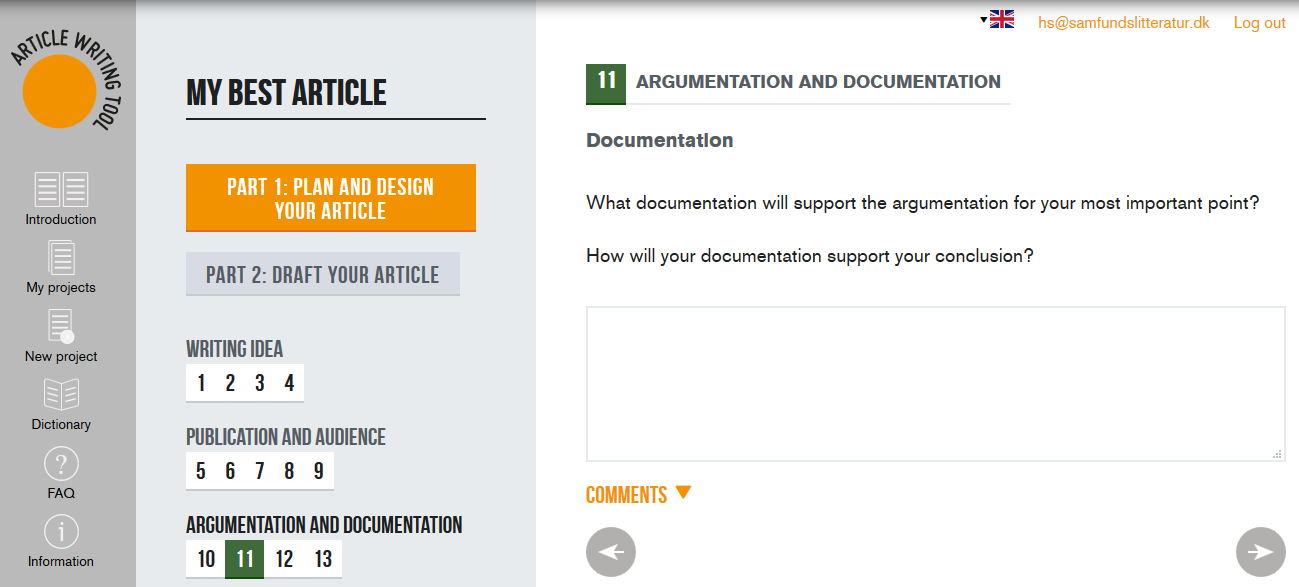
Introduction
Welcome to Article Writing Tool (by Lotte Rienecker)
Welcome to an interactive article tool that can help you who write or co-write an article to plan and draft your next research (peer reviewed research article) or professional article (edited, but not peer reviewed article to a professional, practitioner’s journal). Read more about article types in the programme’s Dictionary.
For new and experienced article writers
You have probably already completed:
- a piece of research or inquiry, scientific or professional, a practitioner’s project - an analysis, discussion, argumentation - a new professional project or a design – or something else that you deem worthy of an article.
New and experienced article writers may benefit from Article Writing Tool. In the article writing process you may:
- not have written the first line - have some draft material that you want to supplement - have a draft that you want to revise and edit – and maybe an editor has asked you for major or minor revisions.
Article Writing Tool may be relevant at all stages of the article writing process to generate more text, to work on an overview, to design a structure – or as a checklist and revision tool.
The tool consists of
- a list of questions and prompts to plan and write all standard elements of your article. Your answers to the questions and prompts may become a draft or a revised version of your article. You get Explanations and Tips along with questions.
- two parts: Part 1 focuses on preliminary reflections, choices and planning. Here you may plan freely without any constraints of any journal’s author guidelines. Part 2 is for writing and drafting – or importing chunks of draft already written. Start on Part 2 if you have already done the preliminary planning of your publication. To get the full benefit of Part 2’s questions, you should choose a journal that you want to submit your article to, to write within the constraints of specific author guidelines.
- a Dictionary with explanations of the central terms and elements of article writing. Read more in Dictionary entries Professional article, Research article and Structure if and when needed.
How to use Article Writing Tool?
Start by Create project in the left hand menu.
You may want to briefly click around the program to get a quick overview.
Start wherever in the program is relevant for you
If you need to plan and design your article, start with Part 1, questions 1-13, which deals with
- the article idea
- choice of publication
- audience
- aims
- argument and main points.
These are the first issues for the article writer to address.
If you feel ready to work on your article draft or to revise it, start at Part 2, ‘Draft your article’, questions 14-36, where you may write all elements of your article. The questions in Part 2 follow the overall structure: Situation, Problem, Solution, Evaluation, and finally References etc. – appendices, references, author profile, etc.
Regard the tool as a checklist and structure guide. The structure in elements and headers in Article Writing Tool do not bind you. You may want to add, skip and omit, or combine elements – according to your material and the author guidelines of the journal you want to submit to.
Article Writing Tool suggests rather than prescribes. View the elements of the tool at suggestions build on the knowledge of recurring article elements, not as rules and prescriptions. The final design of any article depends on the writer(s), the field and materials, co-authors and feedback-givers, and on the journal’s aims and audiences, on the discourse community, of the editors’ intentions and guidelines, and finally of the specific reviewing and editing.
If you are co-authoring, all contributors need to have access to Article Writing Tool. You may work individually in the program and coordinate your drafts (Did you write the same content? Can you add to each other’s work?) – or you may want to divide elements among you and draft each of your elements.
Respond to what is relevant to you. You do not have to follow the sequence of questions and elements. You may want to write your introduction or your conclusion first. If a question seems irrelevant, skip it – at least until later. If a question or an element seems relevant, but requires more research before further drafting, then postpone writing that particular element, and write more loosely about what you need, in order to proceed with your drafting/revising.
Write briefly about each point in order not to lose yourself in any one point. You can always return to and elaborate on an element.
Rewrite and revise! A first draft is exactly that – a first draft only. It may take several drafts before you feel ready to present a draft to your first reader.